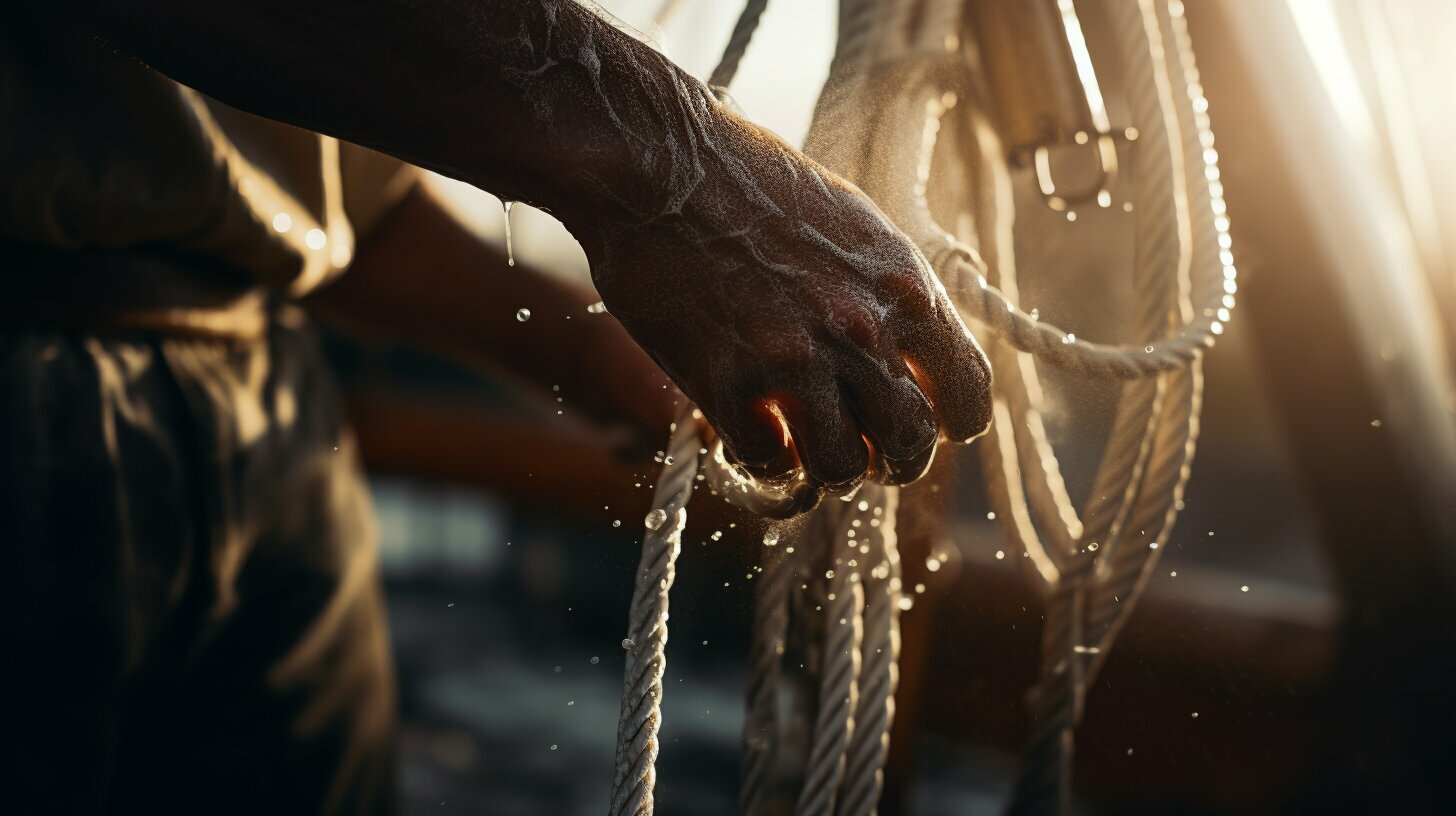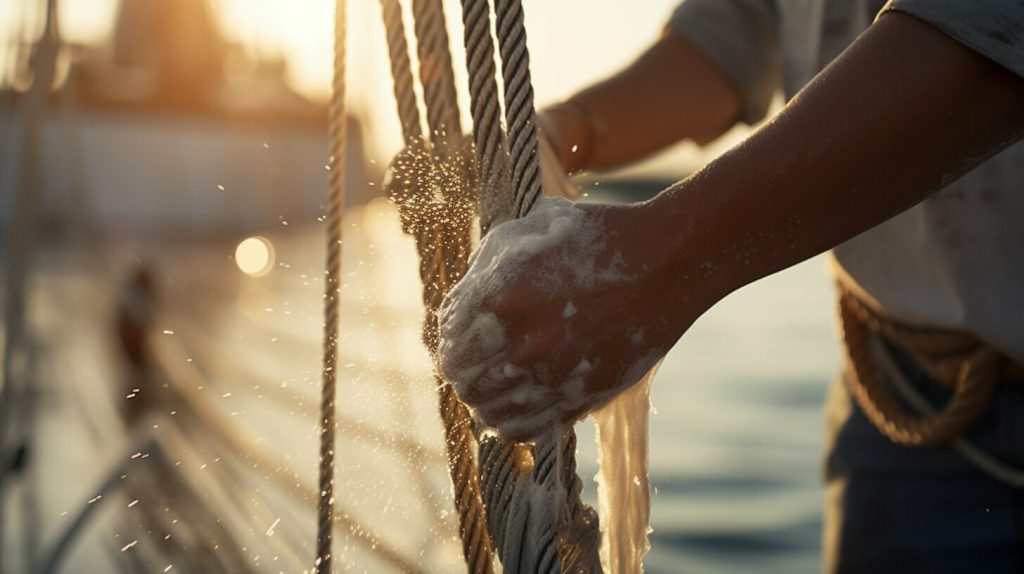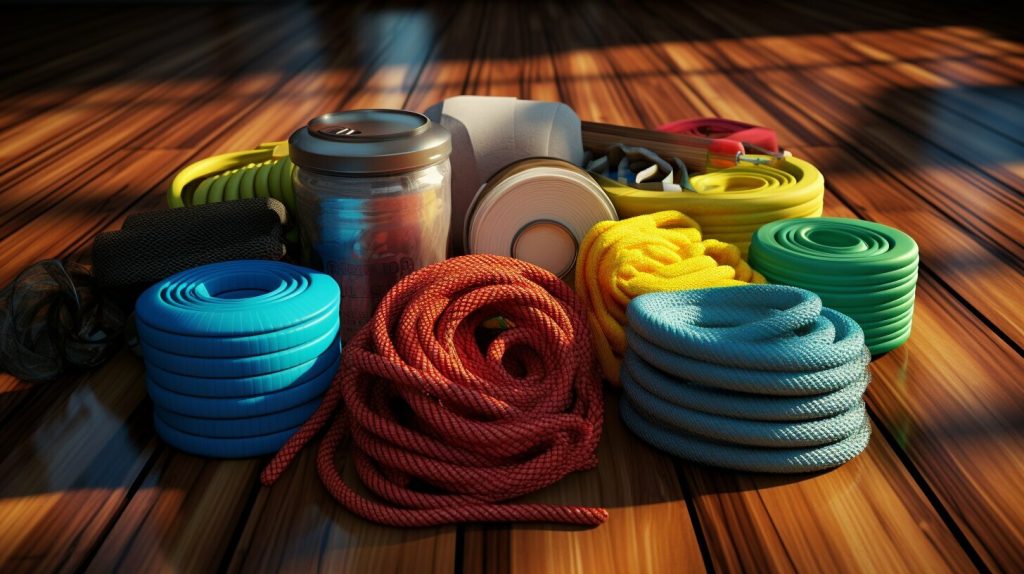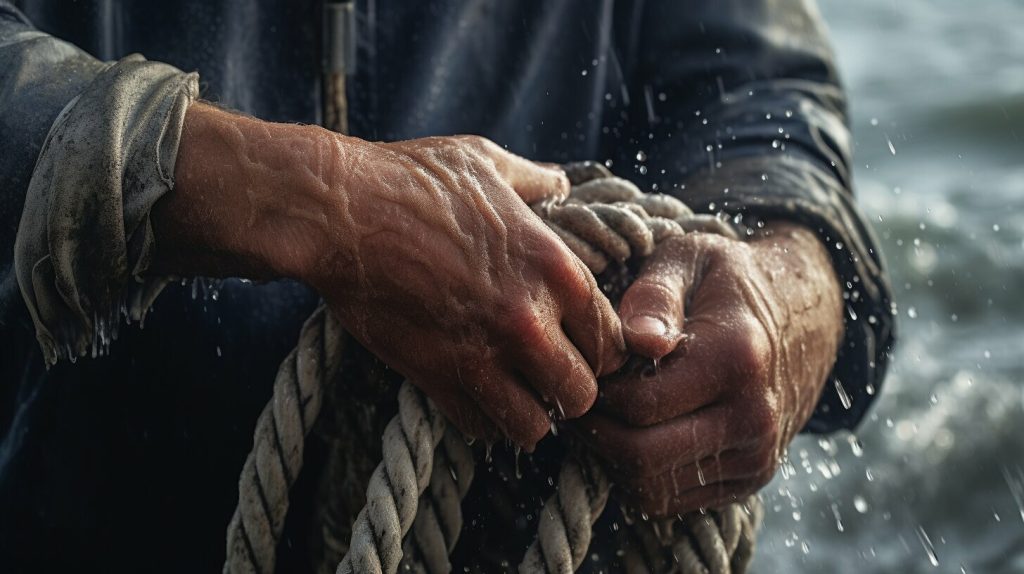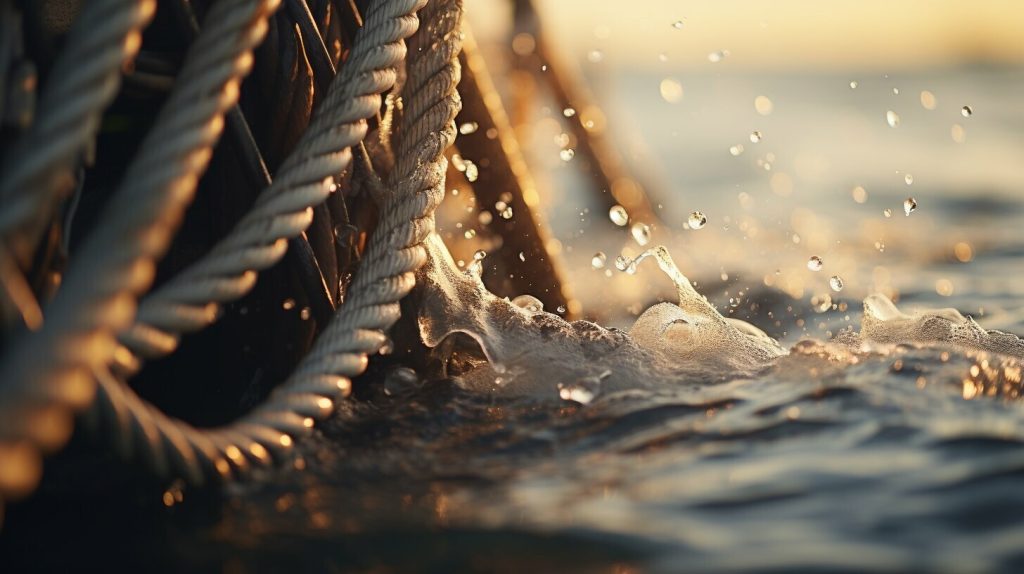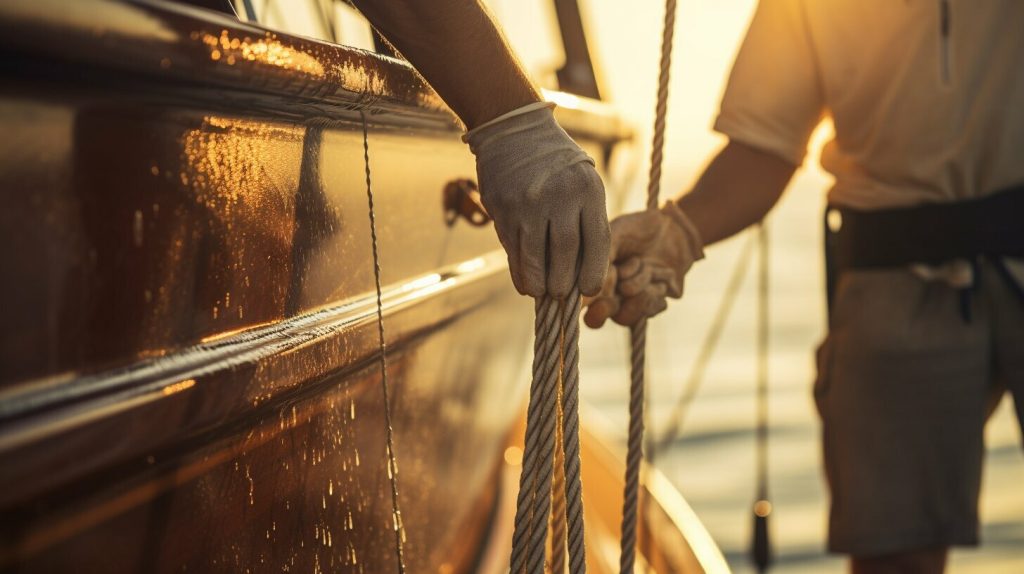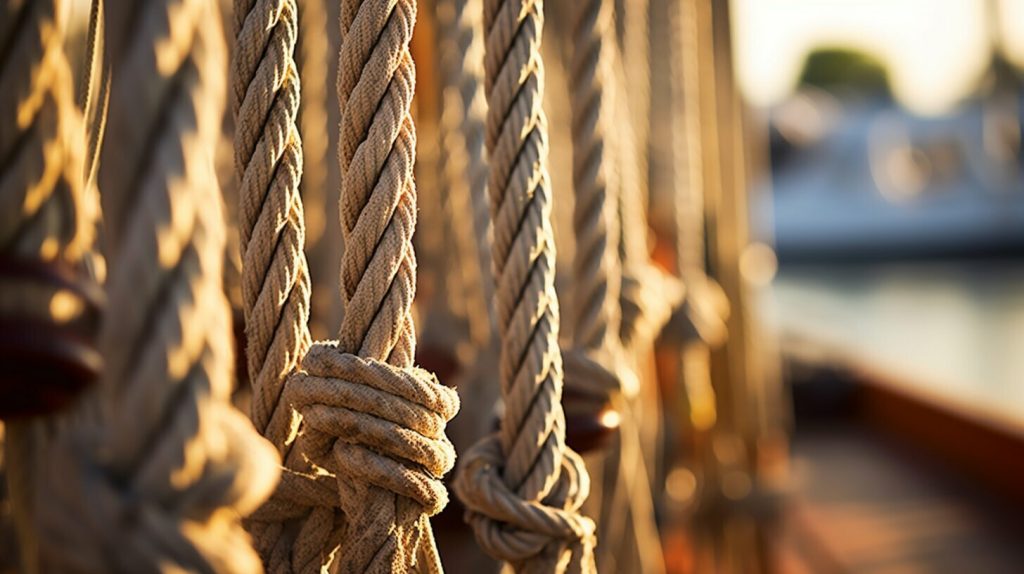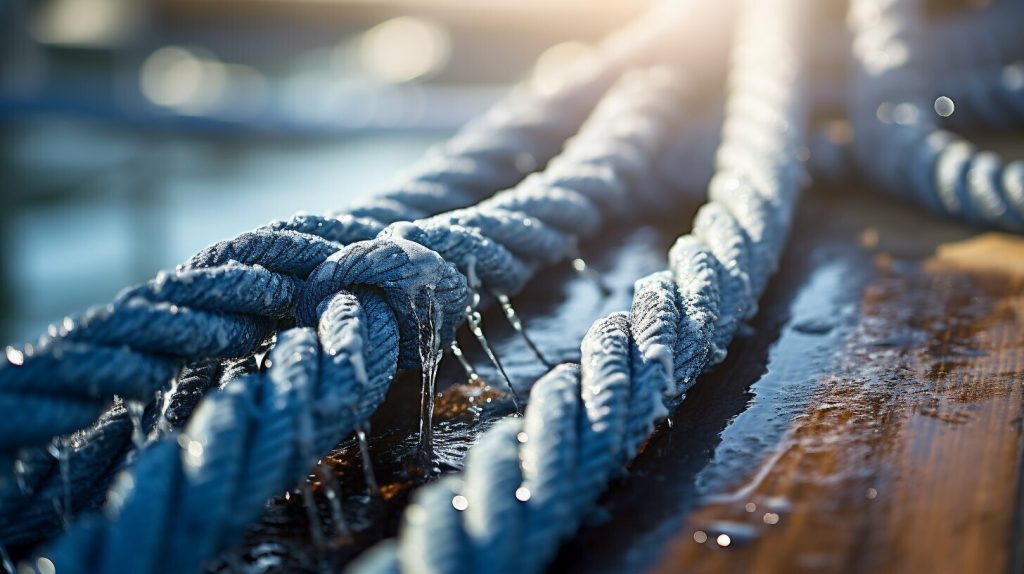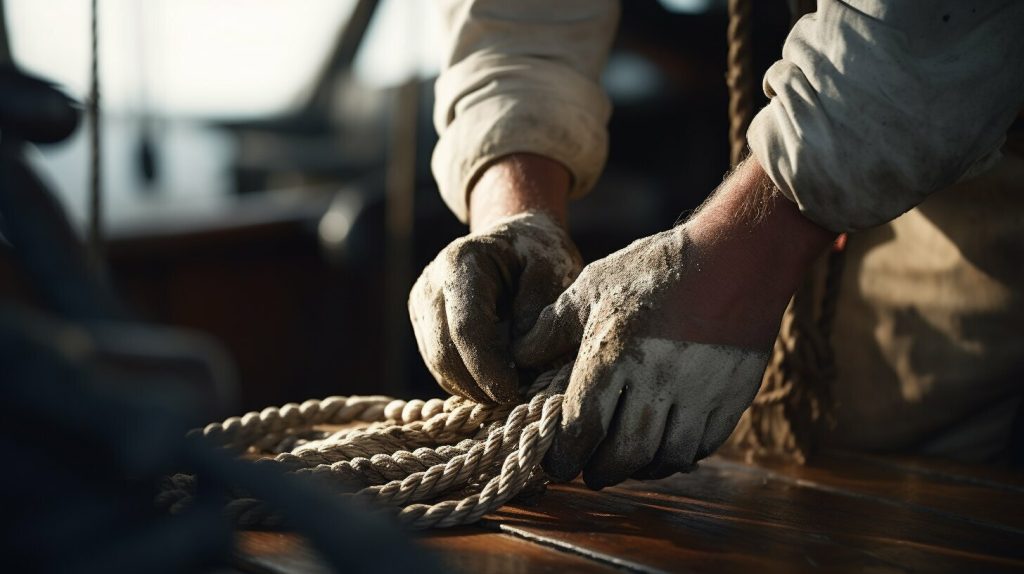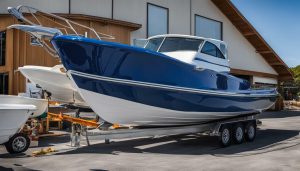As a sailboat owner, maintaining the cleanliness and longevity of your sailing ropes is crucial for a smooth and enjoyable boating experience. Proper rope maintenance not only ensures the durability and performance of your ropes but also enhances your overall sailing experience. In this article, I will guide you on how to clean your sailing ropes with ease, providing you with valuable tips and techniques.
Key Takeaways:
- Regularly clean your sailing ropes to preserve their lifespan and performance.
- Choose mild detergents like Woolite or half-dose laundry detergent for washing.
- Use a freshwater rinse for new ropes to remove salt crystals.
- Avoid cleaners with a pH below 7 or above 9.
- Wash ropes on the gentlest cycle in a coiled or daisy-chained position inside a pillowcase.
Understanding the Importance of Rope Cleaning
Properly cleaning sailing ropes is not only about maintaining their appearance, but it also plays a vital role in preserving their lifespan and ensuring they perform optimally. Regular cleaning removes dirt, salt, and other contaminants that can weaken the fibers and compromise their strength. By following a few simple cleaning tips for sailing rigging, you can keep your ropes in excellent condition and extend their longevity.
When it comes to selecting the right cleaning products, it’s essential to choose mild detergents that are gentle on the ropes. Manufacturers often recommend using Woolite or a half-dose of laundry detergent. These products effectively remove dirt and grime without causing any damage to the ropes. However, it is important to avoid cleaners with a pH below 7 or above 9, as they can cause the fibers to deteriorate.
To wash the ropes, it is recommended to use the gentlest cycle on your washing machine. Coil or daisy-chain the ropes inside a pillowcase to prevent tangling and protect the machine from any potential damage. This method ensures a thorough and even clean. It is important to avoid contact with acids, bases, solvents, and bleach, as they can harm the ropes. Nylon ropes, in particular, are highly susceptible to acids, which can result in rope failure.
After washing, it is crucial to dry the ropes properly. While hot water is safe for nylon and polyester ropes, heat should be avoided during the drying process as it can cause shrinkage and damage. Instead, let the ropes air dry naturally. If you desire added suppleness, use fabric softener at recommended doses during the washing process. This will help maintain the flexibility and smoothness of the ropes.
For heavily soiled ropes, an alternative cleaning method is mechanical cleaning using a rope cleaner tool. This method should be used sparingly and with caution, as it can be abrasive to the ropes if not done properly. Power washing, on the other hand, is not recommended unless done by an experienced operator. It can cut through the ropes and cause hidden damage, compromising their integrity.
| Do’s | Don’ts |
|---|---|
| Use mild detergents like Woolite or half-dose laundry detergent. | Use cleaners with a pH below 7 or above 9. |
| Wash ropes on the gentlest cycle in a pillowcase to prevent tangling. | Expose ropes to acids, bases, solvents, or bleach. |
| Dry ropes naturally without applying heat. | Dry ropes using heat, causing shrinkage and damage. |
| Use fabric softener at recommended doses for added suppleness. | Power wash ropes unless done by an experienced operator. |
By following these cleaning tips and adopting proper rope maintenance practices, you can ensure the longevity of your sailing ropes, preserving their performance and making your sailing experience safer and more enjoyable.
Choosing the Right Cleaning Products
When it comes to cleaning your sailing ropes, it’s important to choose the right cleaning products to avoid damaging the ropes or compromising their integrity. Manufacturers recommend using mild detergents, such as Woolite or a half-dose of laundry detergent, to wash your ropes. These gentle cleansers effectively remove dirt and grime without causing harm. It’s best to avoid cleaners with a pH level below 7 or above 9, as they can be too harsh for the ropes.
Table: Recommended Cleaning Products
| Product | Main Features |
|---|---|
| Woolite | Gentle detergent for delicate fabrics |
| Laundry Detergent (half-dose) | Mild cleanser suitable for most fabrics |
Using the appropriate cleaning products not only ensures the cleanliness of your sailing ropes but also helps maintain their durability and performance. Always follow the manufacturer’s instructions for dilution and usage to achieve the best results.
“Proper cleaning methods and suitable cleaning products are essential for maintaining the longevity of your sailing ropes.”
Proper cleaning methods and suitable cleaning products are essential for maintaining the longevity of your sailing ropes. By choosing the right products, you can effectively remove dirt, salt, and other contaminants, without compromising the strength and integrity of the ropes. It’s also crucial to wash the ropes on the gentlest cycle and ensure they are coiled or daisy-chained within a pillowcase to prevent tangling and protect your washing machine.
To summarize, when it comes to cleaning your sailing ropes, opt for mild detergents like Woolite or a half-dose of laundry detergent. Avoid cleaners with extreme pH levels, and follow the manufacturer’s instructions for dilution and usage. By taking these simple steps, you’ll keep your ropes clean, well-maintained, and ready for your next sailing adventure.
Washing Technique for Sailing Ropes
Cleaning sailing ropes requires a specific washing technique to ensure their cleanliness and longevity, so let’s dive into the best practices for this crucial task. Manufacturers recommend using a mild detergent, such as Woolite or a half-dose of laundry detergent, to wash ropes effectively. These gentle cleaning agents will remove dirt and grime without causing damage.
To begin, it’s important to select the gentlest cycle on your washing machine to avoid the risk of excessive agitation. This will prevent unnecessary stress on the ropes. Before placing the ropes in the machine, it is advisable to coil or daisy-chain them and secure them inside a pillowcase. This technique prevents tangling and protects the washing machine from potential damage caused by loose ropes.
During the washing process, it is crucial to avoid using cleaners with a pH below 7 or above 9, as they can harm the ropes. Acids, bases, and solvents should also be kept away from the cleaning process, as they have the potential to cause irreversible damage. Nylon ropes, in particular, are highly vulnerable to acids, so it is essential to exercise caution.
After washing, drying the ropes correctly is equally important. While hot water is safe to use for nylon and polyester ropes, it is advisable to avoid drying them with heat. High temperatures can cause shrinkage and damage to the rope fibers. Instead, allow the ropes to air dry naturally. To enhance the suppleness of the ropes, consider using fabric softener at the recommended doses. This will help maintain the flexibility and quality of the ropes over time.
Remember, power washing should only be done by experienced operators, as it can lead to hidden damage and even cuts through the ropes. If the ropes are heavily soiled, a safer alternative is the use of a rope cleaner tool specifically designed for mechanical cleaning. This tool can effectively remove stubborn dirt and grime, ensuring that your ropes remain in optimal condition.
| Key Points | Best Practices for Cleaning Sailing Ropes |
|---|---|
| Select a mild detergent | Woolite or half-dose of laundry detergent |
| Choose the gentlest cycle | Avoid excessive agitation |
| Use a pillowcase | Secure ropes inside to prevent tangling |
| Avoid cleaners with extreme pH levels | pH below 7 or above 9 can damage ropes |
| Air dry the ropes | Avoid heat to prevent shrinkage and damage |
| Consider using fabric softener | Enhances rope suppleness |
| Exercise caution with power washing | Hidden damage and cuts can occur |
| Alternative: Rope cleaner tool | For heavily soiled ropes |
Freshwater Rinse for New Ropes
If you have recently acquired new sailing ropes, a freshwater rinse is the first step towards ensuring their longevity and optimal performance. Salt crystals can accumulate on the ropes during manufacturing or storage, and if left untreated, they can cause corrosion and weaken the fibers over time. By giving your new ropes a thorough freshwater rinse, you can remove these salt crystals and prevent potential damage.
| Step | Description |
|---|---|
| 1 | Fill a large container or tub with fresh water. |
| 2 | Submerge the ropes in the water, ensuring they are fully immersed. |
| 3 | Gently agitate the ropes in the water to help dislodge any salt crystals. |
| 4 | Leave the ropes to soak for about 30 minutes. |
| 5 | After soaking, remove the ropes from the water and rinse them thoroughly with fresh water. |
| 6 | Hang the ropes to air dry in a well-ventilated area away from direct sunlight and heat sources. |
Remember to avoid using any cleaning products or harsh chemicals during the freshwater rinse, as they can potentially damage the ropes. Additionally, it is essential to make sure that the water used for rinsing is clean and free from contaminants. Following these steps will help keep your sailing ropes clean and ensure their durability for many sailing adventures to come.
“Keeping your sailing ropes clean is vital for their longevity and performance on the water.”
Avoiding Damaging Substances
It’s essential to be aware of substances that can potentially damage your sailing ropes, as their integrity and performance depend on it. Proper maintenance and cleaning methods are crucial to ensure the longevity of your ropes. When it comes to cleaning sailing rigging, it’s important to avoid acids, bases, solvents, and bleach, as they can cause irreversible damage to the ropes.
Nylon ropes, in particular, are highly vulnerable to acids. The acidic nature of these substances can weaken the fibers, compromising the overall strength and safety of the rope. Avoiding bleach is equally important, as it can cause rope failure due to its corrosive properties. Instead, opt for mild cleaning agents, such as Woolite or a half-dose of laundry detergent, to effectively clean your sailing ropes without causing any harm.
“Proper cleaning methods and avoiding damaging substances are essential for maintaining the performance and durability of your sailboat ropes.”
In addition to acids and bleach, it is also important to steer clear of solvents and bases when cleaning your ropes. These chemicals can break down the fibers and compromise the structural integrity of the rope. To ensure the safety and longevity of your ropes, always read the manufacturer’s guidelines and follow the recommended cleaning methods.
Table: Substances to Avoid for Rope Cleaning
| Substance | Potential Damage |
|---|---|
| Acids (e.g., vinegar, lemon juice) | Weakens fibers, compromises strength |
| Bleach | Causes rope failure, corrosive properties |
| Solvents (e.g., acetone, paint thinner) | Breaks down fibers, compromises structure |
| Bases (e.g., ammonia) | Weakens fibers, compromises strength |
By avoiding these damaging substances and following proper cleaning methods, you can maintain the performance and durability of your sailboat ropes. Remember to always consult the manufacturer’s guidelines and perform regular inspections to spot any signs of damage or wear. Promptly replacing damaged ropes is crucial for ensuring a safe and enjoyable sailing experience.
Drying and Suppleness Enhancement
After cleaning, the drying process and making the ropes more supple are essential steps in maintaining the quality and performance of your sailing ropes. Proper drying techniques and suppleness enhancement methods will ensure that your ropes remain in optimal condition for their intended use.
To dry your ropes safely, avoid using heat as it can cause shrinkage and damage. Instead, hang the ropes in a well-ventilated area away from direct sunlight. This will prevent excessive drying and help maintain their flexibility. Remember, nylon and polyester ropes can withstand hot water during the cleaning process, but heat should be avoided during drying to prevent any potential negative effects.
Suppleness is crucial for the functionality of sailing ropes, as it ensures easy handling and knot tying. To enhance the suppleness of your ropes, consider using fabric softener. Adding fabric softener at recommended doses during the washing process can make the ropes more pliable and easier to work with. This simple step will improve your overall sailing experience and prolong the lifespan of your ropes.
Remember, proper drying and suppleness enhancement are key aspects of sailboat rope care. By following these guidelines, you can maintain the quality and performance of your sailing ropes, ensuring they continue to serve you effectively for years to come.
| Do’s | Don’ts |
|---|---|
|
|
Alternative Cleaning Method: Mechanical Cleaning
For ropes that are heavily soiled and in need of deeper cleaning, mechanical cleaning using a rope cleaner tool can be an effective alternative method. This technique allows for thorough cleaning of the ropes, ensuring that dirt, grime, and salt residues are removed, even from hard-to-reach areas.
Using a rope cleaner tool involves placing the dirty rope inside the cleaning device, which is equipped with rotating brushes or rollers. The rope is then manually or electrically operated through the cleaner, allowing the brushes to scrub away dirt and contaminants. This method is particularly useful for larger, thicker ropes or those that have accumulated stubborn stains over time.
It is important to note that mechanical cleaning should only be used as a last resort, as it can be more abrasive compared to standard washing methods. Prior to using a rope cleaner tool, ensure that it is suitable for the type of rope material you are cleaning. Additionally, follow the manufacturer’s instructions and exercise caution to prevent any potential damage to the ropes.
By incorporating mechanical cleaning into your rope maintenance routine, you can effectively revitalize heavily soiled ropes and extend their lifespan. Remember to always prioritize the gentlest cleaning methods whenever possible and reserve mechanical cleaning for cases where standard washing techniques are insufficient.
| Benefits of Mechanical Cleaning: |
|---|
| Thoroughly cleans heavily soiled ropes |
| Removes dirt, grime, and salt residue from hard-to-reach areas |
| Suitable for larger, thicker ropes |
| Revitalizes ropes with stubborn stains |
Power Washing Precautions
Power washing can be tempting for cleaning sailing ropes, but it’s crucial to exercise caution and ensure it is done by an experienced operator to avoid unintended consequences. While power washing can effectively remove dirt and grime from ropes, it can also cause irreversible damage if not performed correctly.
When using a power washer on sailing ropes, there is a risk of cutting through the ropes or causing hidden damage that may compromise their structural integrity. It’s important to remember that ropes undergo significant stress during sailing, and any weakened areas can lead to failure and potentially dangerous situations at sea.
Before considering power washing, it is essential to assess the condition of the ropes carefully. If they are heavily soiled and conventional cleaning methods have proven ineffective, mechanical cleaning with a rope cleaner tool may be a more suitable alternative. This method can help remove stubborn dirt and grime without the potential risks associated with power washing.
Ultimately, the priority in cleaning and maintaining sailing ropes should be to preserve their longevity and ensure safe sailing experiences. By following best practices and using gentle cleaning methods, such as hand washing with mild detergents or using a rope cleaner tool, sailboat owners can maintain the integrity of their ropes without compromising their safety.
| Pros of Power Washing | Cons of Power Washing |
|---|---|
|
|
Rope Maintenance for Longevity
Cleaning sailing ropes is just one aspect of rope maintenance, so let’s explore some additional tips to ensure their longevity and continued performance.
1. Proper Storage: When not in use, it is important to store your ropes in a dry and clean place. Exposure to moisture, sunlight, and extreme temperatures can weaken the fibers and reduce their lifespan. Consider investing in a rope bag or container that provides protection from environmental elements.
2. Regular Inspections: Routinely inspect your ropes for signs of wear, such as fraying, abrasions, or broken strands. Any damages should be addressed promptly to prevent further deterioration. Look out for any knots, kinks, or tangles that can weaken the rope’s integrity and affect its performance.
| Inspection Checklist | Action |
|---|---|
| Frays or Abrasions | Trim or replace damaged sections. |
| Broken Strands | Replace the entire rope. |
| Knots, Kinks, or Tangles | Untangle and straighten the rope carefully. |
3. Prompt Replacement: Do not hesitate to replace ropes that have reached the end of their lifecycle or show significant signs of wear, as compromised ropes can pose safety risks. Investing in new ropes is a small price to pay for peace of mind and optimal performance.
Remember, proper rope maintenance goes beyond cleaning. By implementing these additional tips, you can extend the lifespan of your sailing ropes and ensure a smoother and safer sailing experience.
Conclusion
By following the simple cleaning techniques and best practices discussed in this article, you can maintain clean, durable, and reliable sailing ropes, enhancing your overall boating experience.
Cleaning sailing ropes is an essential part of rope maintenance to ensure their longevity and optimal performance. Manufacturers recommend using a mild detergent, such as Woolite or a half-dose of laundry detergent, to wash the ropes. For newly acquired ropes, a freshwater rinse is sufficient to remove salt crystals and prevent damage.
It is crucial to choose cleaning products with a pH level between 7 and 9 to avoid harming the ropes. When washing the ropes, use the gentlest cycle on your washing machine and coil or daisy-chain the ropes inside a pillowcase to prevent tangling and protect your machine. Avoid contact with any acids, bases, or solvents as they can cause irreversible damage. Nylon ropes are particularly susceptible to acids, so extra care should be taken while cleaning them.
Do not use bleach to clean ropes, as it can lead to rope failure. While hot water is safe for nylon and polyester ropes, avoid drying them with heat to prevent shrinkage and damage. Instead, use fabric softener at recommended doses to enhance suppleness and maintain the ropes’ flexibility.
If your ropes are heavily soiled, consider using a rope cleaner tool for mechanical cleaning. However, exercise caution and reserve this method for extreme cases. Power washing should only be performed by experienced operators to avoid cutting through the ropes and causing hidden damage.
Remember to store your ropes properly, conduct regular inspections, and promptly replace any damaged ropes to ensure their longevity. By implementing these rope maintenance practices, you can keep your sailing ropes clean, reliable, and ready for your next boating adventure.
FAQ
Q: How do I clean sailing ropes?
A: To clean sailing ropes, manufacturers recommend washing them with a mild detergent, such as Woolite or a half-dose of laundry detergent. You can wash the ropes on the gentlest cycle in a coiled or daisy-chained position inside a pillowcase to prevent tangling and protect the washing machine.
Q: What cleaning products should I use for sailboat ropes?
A: It is best to use mild detergents like Woolite or a half-dose of laundry detergent to clean sailboat ropes. Avoid cleaners with a pH below 7 or above 9, as they can damage the ropes.
Q: Can I use bleach to clean sailing ropes?
A: No, bleach should never be used to clean ropes as it can cause rope failure. It is important to choose mild detergents and avoid harsh chemicals when cleaning sailboat ropes.
Q: How should I dry the ropes after washing them?
A: After washing, nylon and polyester ropes can be dried with hot water, but they should not be dried with heat as it can cause shrinkage and damage. It is best to air dry them. Additionally, fabric softener at recommended doses can be used to make the ropes more supple.
Q: Can power washing be used to clean sailing ropes?
A: Power washing is not recommended unless done by an experienced operator, as it can cut through the ropes and cause hidden damage. It is advisable to use caution and alternative cleaning methods, such as mechanical cleaning for heavily soiled ropes.
Q: How often should I clean and maintain my sailing ropes?
A: It is recommended to regularly clean and maintain your sailing ropes to ensure their longevity and performance. Proper storage, regular inspections, and prompt replacement of damaged ropes are essential for rope maintenance.
